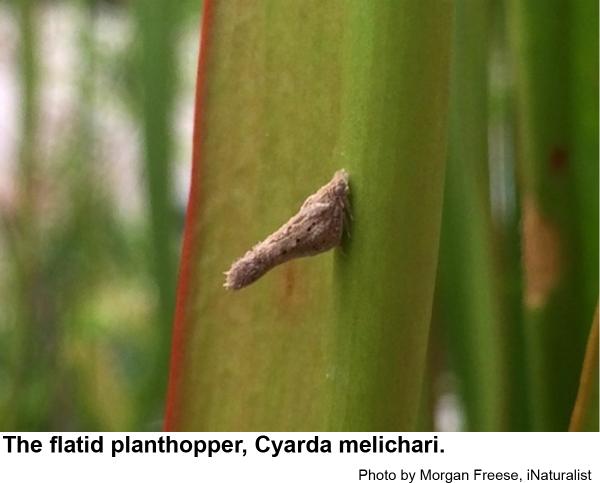Description and Biology
This brown planthopper, Cyarda melichari, is a small (1/8 inch long), but spectacular flatid with wings that are much longer than they are wide. The wings narrow noticeably toward the tip and are held up at an angle, giving this insect the appearance of a thorn. Most other flatids are stockier with broad wings. Little has been published on the biology of this insect, but if it behaves like other flatid planthoppers, adults appear in late spring and are found during the summer. Females insert their eggs into the stem or bark of the current year's growth where the eggs spend the rest of the summer, fall, winter and very early spring. Nymphs hatch next spring and summer and feed by sucking sap through needle-like mouthparts inserted into the bark or leaf. Nymphs are pale with brownish spots and small black dots but they product a fluffy, white secretion that obscures the insect. Sometimes small stems may be completely flocked with the secretion. Development from egg to adult probably takes a little over 5 months. Nymphs are wide and somewhat flat. Nymphs can jump 12 to 18 inches when disturbed, hence the name planthopper. We probably have only one generation per year in North Carolina.
Host Plants
Cyarda melichari has been collected from Chinese bushclover (sericea lespedeza). Another species of Cyarda has been reported from Asclepias viridis, and another from pickleweed and "roadside plants."
Residential Recommendations
Planthoppers and their nymphs can be dislodged by spraying infested shrub with a stream of water from a garden hose. No insecticide is specifically labeled for planthoppers, but insecticides labeled for landscape use should more than adequately suppress them.
Other Resources
- Genus Cyarda. Balaban, J.and J. Balaban. 2017 (update). BugGuide, Iowa State University Department of Entomology.
- Host Plants and Nymphal Descriptions of Acanalonia Pumila and Cyarda Sp. Near acutissima (Homoptera, Fulgoroidea: Acanaloniidae and Flatidae). A. G. Wheeler, A. G. Jr. and R. E. Hoebeke. 1982. Florida Entomologist 65 (3): 340-349.
- Planthoppers of Delaware (Hemiptera, Fulgoroidea), Excluding Delphacidae, with Species Incidence from Adjacent States. Bartlett, C. R. et al. 2011. Zookeys. 2011; (83): 1–42.
- NC State Extension Plant Pathology Publications
- NC State Horticultural Science Publications
- North Carolina Agricultural Chemicals Manual
For assistance with a specific problem, contact your local Cooperative Extension center.
This factsheet has not been peer reviewed.
Publication date: Nov. 6, 2019
Reviewed/Revised: Nov. 6, 2019
Recommendations for the use of agricultural chemicals are included in this publication as a convenience to the reader. The use of brand names and any mention or listing of commercial products or services in this publication does not imply endorsement by NC State University or N.C. A&T State University nor discrimination against similar products or services not mentioned. Individuals who use agricultural chemicals are responsible for ensuring that the intended use complies with current regulations and conforms to the product label. Be sure to obtain current information about usage regulations and examine a current product label before applying any chemical. For assistance, contact your local N.C. Cooperative Extension county center.
N.C. Cooperative Extension prohibits discrimination and harassment regardless of age, color, disability, family and marital status, gender identity, national origin, political beliefs, race, religion, sex (including pregnancy), sexual orientation and veteran status.

